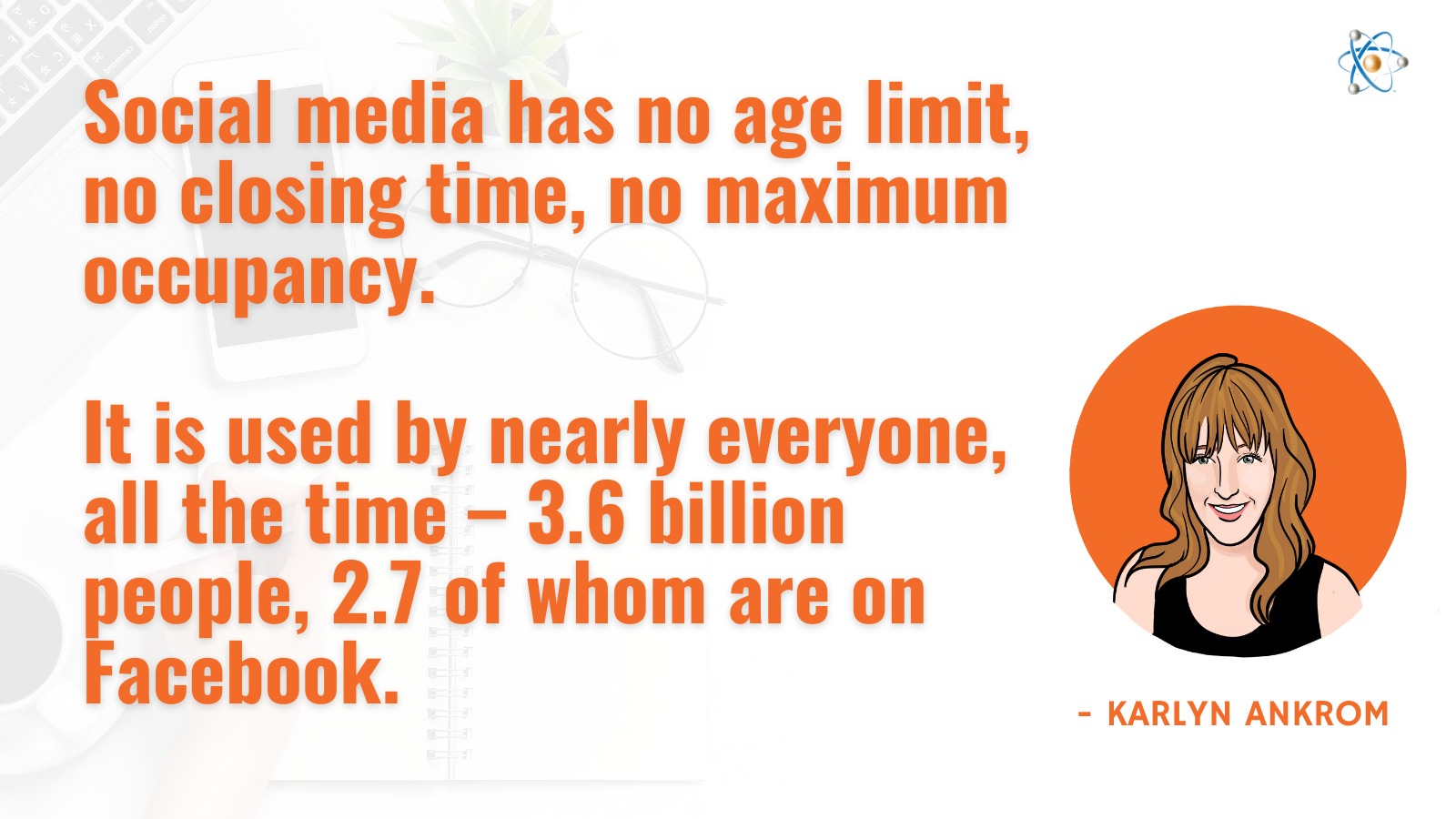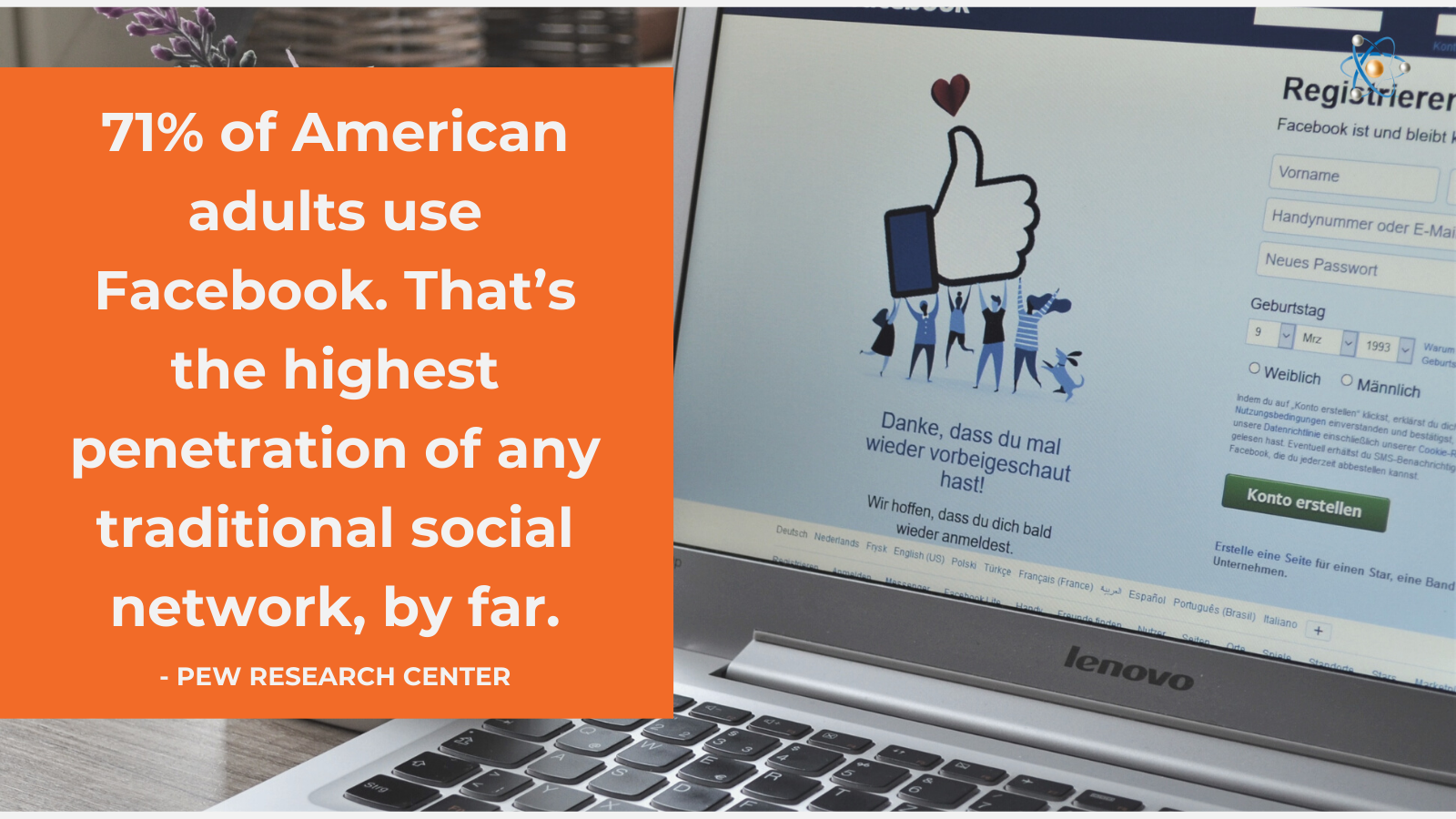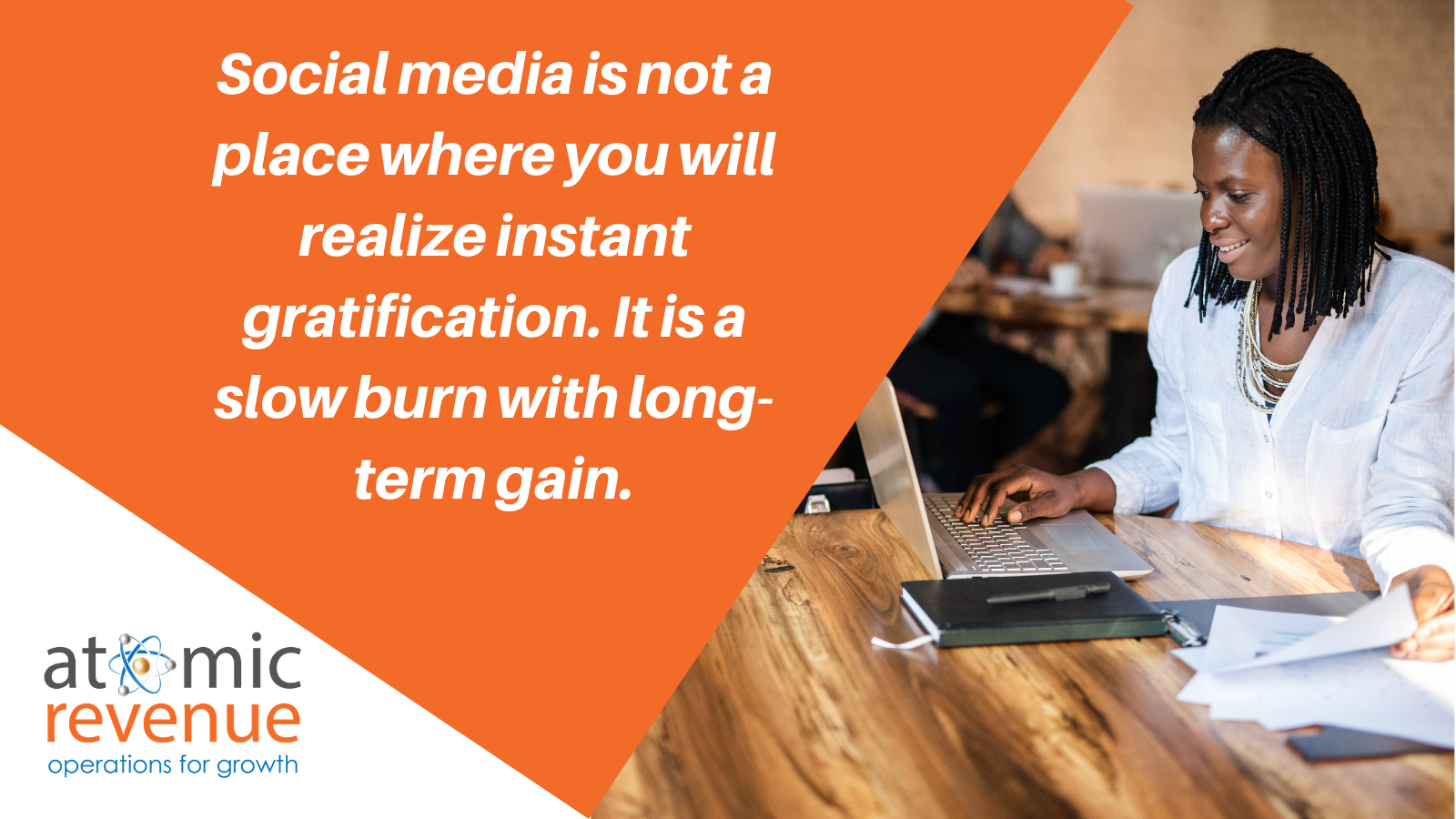
No matter how you slice it, you can’t afford to NOT be on social media. Yes, even you, B2B companies. Regardless of what you sell and who you sell it to – I’ll re-state what we at Atomic Revenue continue to drive home to our clients – you are selling to people. And what do people do when they are not working? How do they communicate with their peers and family, learn new things, keep an eye on their industry, get to know new people at companies, and become inspired? Social media. No matter what products or services you offer, you can benefit from B2B social media marketing.
B2B´s Best Social Networks to Grow
If you and your business are not on social media, or if you have a presence but an inactive one, it’s time to start. You can bet your competitors are there and they are gaining maximum exposure, building their brands, and delighting followers. I know – it’s overwhelming to even think about it. Where do you start?
By reading this blog, you’re taking the first step! Here, you will gain an understanding of why social media is an important tool for B2B companies and their people, as well as which social media networks are best for B2B, how to get started, and what to expect.

Is LinkedIn or Facebook Better for B2B?
One would assume that LinkedIn would be the best social media strategy for B2B companies. However, this is not always the case. Just because you wear your professional hat on LinkedIn doesn’t mean you remove your professional hat when you’re on Facebook. People are multidimensional – they are businesspeople, but they are also mothers, fathers, grandparents, single people with social lives, etc. More than ever, they live in both the business world and personal world simultaneously.
So, which social media platform do you choose for your B2B business engagement – LinkedIn or Facebook – or do you have to choose between them?
Let’s look at an example of how Facebook can inspire action for B2B companies. Sarah is the CEO of a manufacturing plant. She enjoys getting on Facebook at lunchtime to follow her friends, family, and grandchildren. She shrugs her professional identity when connecting, however, she is still a businessperson seeing other posts and ads that will typically be geared toward her specific habits, profession, likes and dislikes.
Your business sells financial services to companies that take in $1+ million a year in revenue. You have a series of paid ads on Facebook. Sarah sees your ads as she’s interacting on Facebook. It’s no coincidence that she has been in conversations with her CFO about this very thing and found your company’s ads compelling. She’s seen them many times over a few months (it takes at least seven touches to get a customer to take action). You’ve been building your brand awareness with her, creating the all-important know, like, and trust factor. Finally, she’s ready to take the next step down the buyer’s journey and clicks to schedule a meeting.
LinkedIn, on the other hand, is a great place for prospecting and sales and to post about your company. No surprise here, it is a platform for business.
Sarah, from the example above, also gets on LinkedIn quickly at lunchtime. After seeing your ads on Facebook, she decides to look for your company here too. She searches for your company’s page to see who works there and what types of information you’re posting – does the company present itself as an expert and do employees and leaders seem trustworthy? Uh-oh. There’s a sad little company page with random posts. There’s nothing from the company’s leaders or employees, just blogs with a lot of industry jargon. This does not inspire her confidence.
If, on the other hand, your LinkedIn page is strong with relevant, customer-centric content, and your employees also post and share your content, Sarah will feel the connection between the Facebook ads and what she’s seeing on LinkedIn, and after looking at your website, would be more likely to click the Contact Us link.
Data shows there are 500 million users on LinkedIn and 2.7 billion on Facebook. The combination of a strong organic presence on both, mixed with some paid ads on Facebook, will give your B2B company the best opportunity for growth.
The more you step out from behind the logo, the better. People don’t buy from logos. They want to do business with people they know, like, and trust. Social media is how people get to know other people.
How to Best Use LinkedIn for B2B
From a data perspective, LinkedIn needs an employee advocacy element and a well-thought out social media strategy behind the company page to make the company content stick and make it work.
People do not engage with a “company” page on LinkedIn. They do not buy from logos. Audiences engage with and buy because of the company’s people. That’s why your content and posts need a peer-to-peer or peer-to-client, human-to-human approach. It is not enough to post a blog or tidbit of info on the company page. Your company’s LinkedIn presence must have the added layer and buy-in of the employees, especially your salespeople, to amplify the company page content.
It seems complicated, but it’s really pretty simple.
- First, make sure the company page content is informative, friendly, customer-focused, and has a consistent cadence (take what’s there and tweak it or create new content).
- Once you’ve done that, you have an approved content library easily accessible on your company page from which your sales team and C-suite can share content to their networks on their profiles, which is what you want.
- Ask your sales teams and C-suite to start sharing the company page content to their profiles and connecting with new contacts. Give them an hour a day (or some company time allotment) to do so, otherwise it probably won’t happen.
How to Use LinkedIn Examples
Here’s an example of how this works. If you have four salespeople and they share your content on their individual pages to a combined 2,600 contacts, that’s 2,600 people in the world who now know about your company and can share your content with their contacts, and so on. Now ask your C-suite to actively share, and the potential is priceless.
Get your sales team and C-suite (and anyone you feel should get involved) in the habit of adding new, relevant contacts to their profiles and sharing content regularly. Your brand will become more visible, awareness will escalate, and your team will natively inspire the know, like, and trust factor that a brand needs to grow.
If your B2B company is not on LinkedIn or doesn’t have a great presence, nor do your salespeople and C-suite, it raises red flags and can conflict with your other social media and website efforts. And, guaranteed – your competition is all over it. If they are there and you are not, what message does that send?
This is one reason Atomic Revenue has a LinkedIn training course to help B2B companies and their people understand how it works, teach them what to post when, and get them in the habit of doing it to maximize reach. Once people see how easy and effective it can be, it becomes a more natural endeavor.

How to Best Use Facebook for Business
Facebook is a little different for B2B. You have to be careful with employees posting things on their personal pages. It’s harder to control what’s being said in that space. However, you can post personal, fun things from your company’s Facebook page and encourage your salespeople, C-suite, and other employees to do the same.
What to Post on Facebook for B2B
Have a bowling league? Post about it. Have an employee birthday or a milestone? Post it. Doing charity work as a company? Share away! This is the kind of content people like to see on social media. It endears your employees to the audience, which makes it more likely they will want to do business with you. Just be sure to stay within your brand’s values. (The same things you post here can also be posted on LinkedIn for double exposure and human-to-human connection.)
It probably goes without saying that a lot of people who engage on Facebook already have a relationship with company leaders and employees of the company, and they already know, like, and trust these people. So, how do you reach NEW people? That’s a whole other strategy that mostly depends on paid ads. We’ll look at that in a moment.

Other B2B Social Media Channels
In addition to LinkedIn and Facebook, there are channels that fit into B2B social media marketing strategies.
- Instagram - If your company provides visual products or services, Instagram should be used in your business.
- YouTube - The more popular video becomes, the more important YouTube is to your business. If you are in a technical industry where you can better show or explain in video, this is especially true.
- Twitter - You can easily communicate directly and quickly with your customers on Twitter. While it may not drive the most sales, you can build relationships and promote engagement.
- Pinterest - B2B companies providing creative services can leverage Pinterest to showcase their work and increase traffic with visual promotion.
How do I Start My Company’s Social Media Strategy?
What used to be a few steps to conversion is now seven. Awareness, inquiry, conversion, satisfaction, retention, expansion, and customer advocacy. Social media assists with all of these steps, but is by large, the top of the funnel – awareness and inquiry. So, how do you start B2B social media marketing and where do you start?
Know Your Business Goals
For B2B to enter the social media landscape, you need to know your SMART goals: strategic, measurable, attainable, relevant, and time-bound.
What is Your Idea of Success
Identify what success looks like for your company on social media. Is it a certain number of conversions or simply better brand awareness?\
Understand the Different Social Channels
Every social network has a different focus along with different user demographics, so do your research first. Don’t just post on a whim.
Which Platforms Match Your Audience
Pinpoint your current audience or who you want your ideal clients to be – what are their job titles? Where else do they hang out on social? Are they grandparents on Facebook engaging with their grandkids or are they techies who love Star Wars and Comic Con? Your audience can be adjusted as the data reveals more.
Collect Social Media Data
Eventually, you’ll want to understand your audience so closely that you can be anticipatory about where they’ll be and when, so you’re in front of them as soon as they jump on social media. This will be supported by data, so you don’t have to physically monitor what is happening.
Reverse engineer the steps above to create compelling content that aims to convert and ultimately maps to your goals for social and overall business objectives.
Then, just START! You can over analyze this to death and get paralyzed with indecision and never start, which is what we encounter most often. Choose a few things you can be consistent with, such as your message, how often you post, and where you post. This creates a cadence in messaging and differentiates you in your industry. Before you know it, you will have developed a full social media strategy.
How do I Measure Results?
When embarking on a Facebook and LinkedIn campaign for your business, once you’ve been at it for a few months, the built-in tools will help you track behavioral data and the content that works on each platform. You can then adjust the tonality of the content and meet your audience where and when it spends the most time. Then you can better track and measure your overall objective’s results. After all, you need to know the ROI of social media activity.
Organic growth:
When you decide to tackle a social strategy with simplicity and stick with the actions you have the resources for, you will start to see the metrics you need to tweak your strategy, super-charge your efforts, and continue to hone the plan. Eventually (3-6 months), when you are consistent, your business and its people will have amplified your reach to contacts who already know, like, and trust you, then those contacts share your company with new like-minded people (advocacy), which can and does attract new social media contacts and potential clients (leads).
When you start an organic posting plan, inform your email list that you’re on social media and invite them to follow you, engage with you there, and ask them to like your page.
Audience Engagement
Keep in mind, it’s important to grow your audience and get page likes, but relevant ones — people who fit your ideal audience demo and will eventually convert into a raving (and paying) clients/customers. Put simply, don’t get hung up on the number of followers or likes you have, focus on whether those fans, overtime, are doing business with your company. To attract your ideal audience to your corner of the social media landscape, have a contest, share a case study, create engaging content that people want to share.
The ultimate goal is engaging with your audience. Likes and follows don't pay the bills. You need to find the social media audience that's interests match your offerings. This will better convert social media followers into customers and fans. But remember, continue to drive customer engagement even after they purchase.
Another strategy to get people to join the conversation on social media is adding your social media links to your email signature. You and your team send hundreds of emails per month, why not take advantage of that exposure?
Don’t be afraid to post – there is no such thing as posting too much. Just because you feel like a broken record on social, you can’t stop. You are moving the needle because you’re showing up. If you’re not showing up, your competitors will win because they are showing up. They’re nurturing the audience you are missing out on.
Paid growth:
As you’re working your organic posting and engagement strategy, it helps to place paid ads on Facebook. Paid ads will get you where you’re going faster, and they are easier to track. Ads should have a strong call to action (CTA) and typically link to a page on your website or a specific landing page for the ad. This gives you control over your data and allows you to better use lead scoring and other KPIs to measure the efficacy of your efforts so you can adjust as necessary.
How do I Know if It’s Working?
Data. Data. Data.
Social media requires patience, and did I mention … data? There is an extended timeframe for useful data. Three months is a good starting point, then tweak. Data is better at six months, and even better still at a year. The more time you give it, the more info your data will provide so you can adjust and hone your strategy and take it to next level. And, the entire time, you’re building you brand, creating fans, opening the lines of communication with clients and potentials, and potentially increasing sales. If you pay for strategically created and placed Facebook ads, after time and a few tweaks based on data, you should see a clear and measurable ROI.
Let’s look at a paid ad example of ROI. For every 100 contacts you receive, let’s say you book 20 calls. From those 20, ten are qualified contacts. Of those 10, two make a purchase. If each new customer has a LifeTime Value (LTV) of spending $12,000 with your company, working back up the sales process, every 100 contacts turn into $24,000 of gross income.
Of the $24,000 gross income, there are $12,000 in expenses, leaving you with $12,000 in profit. Therefore, if you spend less than $12,000 per 100 contacts you receive, you will be profitable. Where it previously may have felt extremely expensive to pay $50 for a contact when you have a 2% close rate, now that you know your profit is $120 per contact, that price makes much more sense. Very few other types of marketing programs enable you to measure your ROI so clearly and directly.
How Does our B2B Company Justify the Social Media Time Investment and Cost?
This is a great question. How do you justify the time-spend and cost of social media when you have no useful data and no way to track it for up to a year? The answer is more of a reverse engineered question. If you’re not showing up, how much are you losing to your competitors who are showing up?
Social media is a necessary tool that must be used strategically to be effective. As much as social can help, not being there can hurt. Follow a few golden rules and, with patience and fortitude, you will get you where you want to be.
- Have a goal and work it consistently – do not stop.
- Show your human side – it’s not all about the logo.
- Focus on top of funnel first.
- Have conversations with your ideal audience/prospects.
- Guide followers to the next step to get them to take action.
- You MUST present the opportunity with a strong call to action (CTA). You can be entertaining and educating all you want, but if you don’t have a link to book a consult or a call to learn more, you’re missing the boat.
- Continue customer engagement on social after the sale.
When it comes to social media for B2B companies, it is no different than B2C. People buy from people and social media is where people interact. Now that there are fewer opportunities to meet in person for the foreseeable future, it’s even more important to have a presence and be there for your clients, show up for those who need your services or products but haven’t found you yet or are just getting to know you.
And, in case you’re wondering, I did not forget about Twitter and Instagram, but for the sake of this blog and the relevance of revenue-generating activities, though they can be great for brand-building, it is more complicated to track ROI and not the best place to start if your B2B company is new to the social media realm.

Need Some B2B Social Media Help? We’ve Got You Covered!
While getting your social strategy systems in place might seem like one of those daunting heaps of work that warrant a nice cry, every bit of effort makes itself evident. Yes, more likes. More follows. But more than that, more connection with the people who make your business possible.
If you are struggling to get your business into the social media world or you’re not sure if you need to be there, contact us today. Our experts can assess your social needs, help you create a plan, choose the best platform for your B2B company based on data, and if needed, manage your social media for you. Our consultations are free, and we love to help.
 About the Author
About the Author
Karlyn Ankrom is the founder of Oh Snap! Social and the Fan Firestarter™ Framework, a new approach to social media marketing made specifically for businesses who have a difficult time with the even the thought of social media. Karlyn is also a Social Media Content Manager at Atomic Revenue, helping our clients – a variety of B2B businesses who were decidedly “social allergic”– find their voice and get incredible results from social media.




